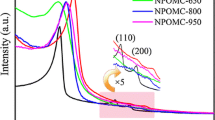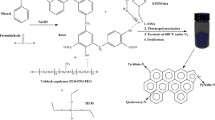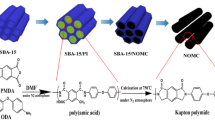Abstract
Heteroatom-doped mesoporous carbons have gained significant attention for their high energy density in supercapacitors. In this present study, we report the synthesis of nitrogen (N) and phosphorous (P) co-doped ordered mesoporous carbon (NPMC) by a simple and scalable technique wet impregnation method in one step using an ordered mesoporous silica template (SBA-15). Low-angle XRD patterns, transmission electron micrographs and N2 sorption measurement confirmed the synthesized materials ordered mesoporous nature (interconnected honeycomb 2D hexagonal pores of size ~ 10 nm). The charge storage capacity of NPMC is explored both in aqueous and non-aqueous electrolytes. NPMC exhibited a significant faradaic process in an aqueous medium, whereas it was absent in non-aqueous. NPMC delivered a high specific capacitance of 183 F g−1 with remarkable capacitance retention of 94% even after 10000 charge–discharge cycles at 5 A g−1 current density in the aqueous medium. In a non-aqueous medium, NPMC exhibited an impressive energy density and power density of 41 Wh kg−1 (@1 A g−1) and 14400 W kg−1 (@20 A g−1), respectively. The retention of the ordered mesoporous structure of carbon with doping is the novelty of this work. It paves new ways to generate high-performance materials compared to the undoped ones for supercapacitor and battery applications.
Graphical abstract











Similar content being viewed by others
References
Conway BE (1999) Electrochemical supercapacitors scientific fundamentals and technological applications. ISBN 978-1-4757-3058-6.
Miller JR, Simon P (2008) Electrochemical capacitors for energy management. Science 321:651–652. https://doi.org/10.1126/science.1158736
Sarangapani S, Tilak BV, Chen CP (1996) Materials for electrochemical capacitors: theoretical and experimental constraints. J Electrochem Soc 143:3791–3799. https://doi.org/10.1149/1.1837291
Zhang LL, Zhao XS (2009) Carbon-based materials as supercapacitor electrodes. Chem Soc Rev 38:2520–2531. https://doi.org/10.1039/B813846J
Bruce PG, Scrosati B, Tarascon J-M (2008) Nanomaterials for rechargeable lithium batteries. Angew Chem Int Ed 47:2930–2946. https://doi.org/10.1002/anie.200702505
Simon P, Gogotsi Y (2008) Materials for electrochemical capacitors. Nat Mater 7:845–854. https://doi.org/10.1038/nmat2297
Song Z, Miao L, Li L, Zhu D, Gan L, Liu M (2021) A robust strategy of solvent choice to synthesize optimal nanostructured carbon for efficient energy storage. Carbon 180:135–145. https://doi.org/10.1016/j.carbon.2021.04.078
Xia X, Zhang Y, Chao D, Guan C, Zhang Y, Li L, Ge X, Bacho IM, Tu J, Fan HJ (2014) Solution synthesis of metal oxides for electrochemical energy storage applications. Nanoscale 6:5008–5048. https://doi.org/10.1039/C4NR00024B
Lota G, Fic K, Frackowiak E (2011) Carbon nanotubes and their composites in electrochemical applications. Energy Environ Sci 4:1592–1605. https://doi.org/10.1039/C0EE00470G
Wu Z-S, Zhou G, Yin L-C, Ren W, Li F, Cheng H-M (2012) Graphene/metal oxide composite electrode materials for energy storage. Nano Energy 1:107–131. https://doi.org/10.1016/j.nanoen.2011.11.001
Bryan AM, Santino LM, Lu Y, Acharya S, D’Arcy JM (2016) Conducting polymers for pseudocapacitive energy storage. Chem Mater 28:5989–5998. https://doi.org/10.1021/acs.chemmater.6b01762
Yue X, Yang H, Cao Y, Jiang L, Li H, Shi F, Liu J (2022) Nitrogen-doped cornstalk-based biomass porous carbon with uniform hierarchical pores for high-performance symmetric supercapacitors. J Mater Sci 57:3645–3661. https://doi.org/10.1007/s10853-022-06891-9
Du W, La M, Song Z, Zheng X, Lv Y, Zhu D, Gan L, Liu M (2022) Kinetics-driven design of 3D VN/MXene composite structure for superior zinc storage and charge transfer. J Power Sources 536:231512. https://doi.org/10.1016/j.jpowsour.2022.231512
Duan H, Song Z, Miao L, Li L, Zhu D, Gan L, Liu M (2022) Unraveling the role of solvent–precursor interaction in fabricating heteroatomic carbon cathode for high-energy-density Zn-ion storage. J Mater Chem A 10:9837–9847. https://doi.org/10.1039/D2TA00754A
Ghotbi MY, Javanmard A, Soleimani H (2021) Layered nanoreactor assisted to produce B-doped and P-doped 3D carbon nanostructures for supercapacitor electrodes. J Energy Storage 44:103514. https://doi.org/10.1016/j.est.2021.103514
Stoller MD, Park S, Zhu Y, An J, Ruoff RS (2008) Graphene-based ultracapacitors. Nano Lett 8:3498–3502. https://doi.org/10.1021/nl802558y
Baughman RH, Zakhidov AA, Heer WAD (2002) Carbon nanotubes-the route toward applications. Science 297:787–792. https://doi.org/10.1126/science.1060928
Wang K, Wang Y, Wang Y, Hosono E, Zhou H (2009) Mesoporous carbon nanofibers for supercapacitor application. J Phys Chem C 113:1093–1097. https://doi.org/10.1021/jp807463u
Kesavan T, Partheeban T, Vivekanantha M, Kundu M, Maduraiveeran G, Sasidharan M (2019) Hierarchical nanoporous activated carbon as potential electrode materials for high performance electrochemical supercapacitor. Microporous Mesoporous Mater 274:236–244. https://doi.org/10.1016/j.micromeso.2018.08.006
Kesavan T, Sasidharan M (2019) Palm spathe derived N-doped carbon nanosheets as a high performance electrode for Li-ion batteries and supercapacitors. ACS Sustain Chem Eng 7:12160–12169. https://doi.org/10.1021/acssuschemeng.9b01261
Peng H, Yao B, Wei X, Liu T, Kou T, Xiao P, Zhang Y, Li Y (2019) Pore and heteroatom engineered carbon foams for supercapacitors. Adv Energy Mater 9:1803665. https://doi.org/10.1002/aenm.201803665
Raja M, Sadhasivam B, Naik RJ, Dhamodharan R, Ramanujam K (2019) A chitosan/poly(ethylene glycol)-ran-poly(propylene glycol) blend as an eco-benign separator and binder for quasi-solid-state supercapacitor applications. Sustain Energy Fuels 3:760–773. https://doi.org/10.1039/C8SE00530C
Zhou H, Zhu S, Hibino M, Honma I, Ichihara M (2003) Lithium storage in ordered mesoporous carbon (CMK-3) with high reversible specific energy capacity and good cycling performance. Adv Mater 15:2107–2111. https://doi.org/10.1002/adma.200306125
Stein A, Wang Z, Fierke MA (2009) Functionalization of porous carbon materials with designed pore architecture. Adv Mater 21:265–293. https://doi.org/10.1002/adma.200801492
Mao Y, Duan H, Xu B, Zhang L, Hu Y, Zhao C, Wang Z, Chen L, Yang Y (2012) Lithium storage in nitrogen-rich mesoporous carbon materials. Energy Environ Sci 5:7950–7955. https://doi.org/10.1039/C2EE21817H
Chen W, Wan M, Liu Q, Xiong X, Yu F, Huang Y (2019) Heteroatom-doped carbon materials: synthesis, mechanism, and application for sodium-ion batteries. Small Methods 3:1800323. https://doi.org/10.1002/smtd.201800323
Abbas Q, Raza R, Shabbir I, Olabide AG (2019) Heteroatom doped high porosity carbon nanomaterials as electrodes for energy storage in electrochemical capacitors: a review. J Sci Adv Mater Devices 4:341–352. https://doi.org/10.1016/j.jsamd.2019.07.007
Vinu A (2008) Two-Dimensional hexagonally-ordered mesoporous carbon nitrides with tunable pore diameter, surface area and nitrogen content. Adv Funct Mater 18:816–827. https://doi.org/10.1002/adfm.200700783
Shi Q, Zhang R, Lv Y, Deng Y, Elzatahrya AA, Zhao D (2015) Nitrogen-doped ordered mesoporous carbons based on cyanamide as the dopant for supercapacitor. Carbon 84:335–346. https://doi.org/10.1016/j.carbon.2014.12.013
Wu J, Yang Z, Li X, Sun Q, Jin C, Strasserd P, Yang R (2013) Phosphorus-doped porous carbons as efficient electrocatalysts for oxygen reduction. J Mater Chem A 1:9889–9896. https://doi.org/10.1039/C3TA11849E
Xu Y, Tomita A, Takashi K (2005) Double coaxial structure and dual physicochemical properties of carbon nanotubes composed of stacked nitrogen-doped and undoped multiwalls. Chem Mater 17:2940–2945. https://doi.org/10.1021/cm047830m
Cai J, Wu C, Zhu Y, Zhang K, Shen PK (2017) Sulfur impregnated N, P-co-doped hierarchical porous carbon as cathode for high performance Li-S batteries. J Power Sources 341:165–174. https://doi.org/10.1016/j.jpowsour.2016.12.008
Gao Y, Wang Q, Ji G, Li A, Niu J (2021) Doping strategy, properties and application of heteroatom-doped ordered mesoporous carbon. RSC Adv 11:5361–5383. https://doi.org/10.1039/D0RA08993A
Xin X, Kang H, Feng J, Sui L, Dong H, Zhao P, Pang B, Chen Y, Sun Q, Ma S, Zhang R, Dong L, Yu L (2020) A novel sol-gel strategy for N, P dual-doped mesoporous carbon with high specific capacitance and energy density for advanced supercapacitors. Chem Eng J 393:124710. https://doi.org/10.1016/j.cej.2020.124710
Zhang D, Zheng L, Ma Y, Lei L, Li Q, Li Y, Luo H, Feng H, Hao Y (2014) Synthesis of nitrogen- and sulfur-codoped 3d cubic-ordered mesoporous carbon with superior performance in supercapacitors. ACS Appl Mater Interfaces 6:2657–2665. https://doi.org/10.1021/am405128j
Panja T, Bhattacharjya D, Yu J-S (2015) Nitrogen and phosphorus co-doped cubic ordered mesoporous carbon as a supercapacitor electrode material with extraordinary cyclic stability. J Mater Chem A 3:18001–18009. https://doi.org/10.1039/C5TA04169D
Liang K, Wang W, Yu Y, Liu L, Lv H, Zhang Y, Chen A (2019) Synthesis of nitrogen-doped mesoporous carbon for high-performance supercapacitors. New J Chem 43:2776–2782. https://doi.org/10.1039/C8NJ05938A
Zhou J, Ye S, Zeng Q, Yang H, Chen J, Guo Z, Jiang H, Rajan K (2020) Nitrogen and phosphorus co-doped porous carbon for high-performance supercapacitors. Front Chem 8:1–8. https://doi.org/10.3389/fchem.2020.00105
Yang Q, Huang J, Tu J, Wu K, Huang H, Wang D, Yao J, Li L (2021) A micropore-dominant N, P, S-codoped porous carbon originating from hydrogel for high-performance supercapacitors mediated by phytic acid. Microporous Mesoporous Mater 316:110951. https://doi.org/10.1016/j.micromeso.2021.110951
Zhou Y, Tang L, Yang G, Zeng G, Deng Y, Huang B, Cai Y, Tang J, Wang J, Wu Y (2016) Phosphorus-doped ordered mesoporous carbons embedded with Pd/Fe bimetal nanoparticles for the dechlorination of 2,4-dichlorophenol. Catal Sci Technol 6:1930–1939. https://doi.org/10.1039/C5CY01514F
Song W, Kan J, Wang H, Zhao X, Zheng Y, Zhang H, Tao L, Huang M, Liu W, Shi J (2019) Nitrogen and sulfur co-doped mesoporous carbon for sodium ion batteries. ACS Appl Nano Mater 2:5643–5654. https://doi.org/10.1021/acsanm.9b01178
Xie K, Zhang M, Yang Y, Zhao L, Qi W (2018) Synthesis and supercapacitor performance of polyaniline/nitrogen-doped ordered mesoporous carbon composites. Nanoscale Res Lett 13:163. https://doi.org/10.1186/s11671-018-2577-3
Subramani K, Shunmugasundaram S, Duraisamy V, Ilavarasi R, Kumar SMS, Sathish M (2022) Dual heteroatoms doped SBA-15 templated porous carbon for symmetric supercapacitor in dual redox additive electrolyte. J Colloid Interface Sci 606:286–297. https://doi.org/10.1016/j.jcis.2021.08.002
Lin Y, Hu Z, Shao Y, Chen Z, Wei X, Wu Z (2021) Single-precursor design and solvent-free nanocasting synthesis of N/S/O-doped ordered mesoporous carbons with trimodal pores for excellent oxygen reduction. Carbon 183:390–403. https://doi.org/10.1016/j.carbon.2021.07.030
Jun S, Joo SH, Ryoo R, Kruk M, Jaroniec M, Liu Z, Ohsuna T, Terasaki O (2000) Synthesis of new, nanoporous carbon with hexagonally ordered mesostructure. J Am Chem Soc 122:10712–10713. https://doi.org/10.1021/ja002261e
Kesavan T, Partheeban T, Vivekanantha M, Prabu N, Kundu M, Premkumar S, Umapathy S, Vinu A, Sasidharan M (2020) Design of P-doped mesoporous carbon nitrides as high performance anode materials for Li ion battery. ACS Appl Mater Interfaces 12:24007–24018. https://doi.org/10.1021/acsami.0c05123
Chen LF, Huang ZH, Liang HW, Gao HL, Yu SH (2014) Three-Dimensional heteroatom-doped carbon nanofiber networks derived from bacterial cellulose for supercapacitors. Adv Funct Mater 24:5104–5111. https://doi.org/10.1002/adfm.201400590
Wei D, Liu Y, Cao L, Fu L, Li X, Wang Y, Yu G, Zhu D (2006) A new method to synthesize complicated multibranched carbon nanotubes with controlled architecture and composition. Nano Lett 6:186–192. https://doi.org/10.1021/nl051955o
Ferrari AC, Meyer JC, Scardaci V, Casiraghi C, Lazzeri M, Mauri F, Piscanec S, Jiang D, Novoselov KS, Roth S, Geim AK (2006) Raman spectrum of graphene and graphene layers. Phys Rev Lett 97:187401–187404. https://doi.org/10.1103/PhysRevLett.97.187401
Kesavan T, Saravanan RSA, Dharaneshwar S, Prabu N, Sasidharan M (2021) N-Doped carbon nanosheets from biomass for ultra long-cycling and high energy density symmetric supercapacitors. ECS J Solid State Sci Technol 10:051004. https://doi.org/10.1149/2162-8777/abfd04
Cui Y, Zhang J, Zhang G, Huang J, Liu P, Antonietti M, Wang X (2011) Synthesis of bulk and nanoporous carbon nitride polymers from ammonium thiocyanate for photocatalytic hydrogen evolution. J Mater Chem 21:13032–13039. https://doi.org/10.1039/C1JM11961C
Claeyssens F, Fuge GM, Allan NL, May PW, Ashfold MNR (2004) Phosphorus carbides: theory and experiment. Dalton Trans, 3085–3092. https://doi.org/10.1039/B402740J
Blanchard PER, Grosvenor AP, Cavell RG, Mar A (2008) X-ray photoelectron and absorption spectroscopy of metal-rich phosphides M2P and M3P (M = Cr−Ni). Chem Mater 20:7081–7088. https://doi.org/10.1021/cm802123a
Chao S, Zou F, Wan F, Dong X, Wang Y, Wang Y, Guan Q, Wang G, Li W (2017) Nitrogen-doped carbon derived from ZIF-8 as a high-performance metal-free catalyst for acetylene hydrochlorination. Sci Rep 7:39789. https://doi.org/10.1038/srep39789
Cai W, Ding J, He Y, Chen X, Yuan D, Chen C, Cheng L, Du W, Wan H, Guan G (2021) Nitrogen-doped microporous carbon prepared by one-step carbonization: Rational design of a polymer precursor for efficient CO2 capture. Energy Fuels 35:8857–8867. https://doi.org/10.1021/acs.energyfuels.1c00294
Choi CH, Park SH, Woo SI (2012) Phosphorus–nitrogen dual doped carbon as an effective catalyst for oxygen reduction reaction in acidic media: effects of the amount of P-doping on the physical and electrochemical properties of carbon. J Mater Chem 22:12107–12115. https://doi.org/10.1039/C2JM31079A
Kumar MP, Kesavan T, Kalita G, Ragupathy P, Narayanan TN, Pattanayak DK (2014) On the large capacitance of nitrogen doped graphene derived by a facile route. RSC Adv 4:38689–38697. https://doi.org/10.1039/C4RA04927FM
Karnan M, Subramani K, Sudhan N, Ilayaraja N, Sathish M (2016) Aloe vera derived activated high-surface-area carbon for flexible and high-energy supercapacitors. ACS Appl Mater Interfaces 8:35191–35202. https://doi.org/10.1021/acsami.6b10704
Jiao W, Li N, Wang L, Wen L, Li F, Liu G, Cheng H-M (2013) High-rate lithium storage of anatase TiO2 crystals doped with both nitrogen and sulfur. Chem Comm 49:3461–3463. https://doi.org/10.1039/C3CC40568K
Senthil C, Kesavan T, Bhaumik A, Yoshio M, Sasidharan M (2017) Nitrogen rich carbon coated TiO2 nanoparticles as anode for high performance lithium-ion battery. Electrochim Acta 255:417–427. https://doi.org/10.1016/j.electacta.2017.10.001
Augustyn V, Simon P, Dunn B (2014) Pseudocapacitive oxide materials for high-rate electrochemical energy storage. Energy Environ Sci 7:1597–1614. https://doi.org/10.1039/C3EE44164D
Stoller MD, Ruoff RS (2010) Best practice methods for determining an electrode material’s performance for ultracapacitors. Energy Environ Sci 3:1294–1301. https://doi.org/10.1039/C0EE00074D
Stoller MD, Murali S, Quarles N, Zhu Y, Potts JR, Zhu X, Ha H-W, Ruoff RS (2012) Activated graphene as a cathode material for li-ion hybrid supercapacitors. Phys Chem Chem Phys 14:3388–3391. https://doi.org/10.1039/C2CP00017B
Tian X, Ma H, Li Z, Yan S, Ma L, Yu F, Wang G, Guo X, Ma Y, Wong C (2017) Flute type micropores activated carbon from cotton stalk for high performance supercapacitors. J Power Sources 359:88–96. https://doi.org/10.1016/j.jpowsour.2017.05.054
Abraham DP, Reynolds EM, Schultz PL, Jansen AN, Dees DW (2006) Temperature dependence of capacity and impedance data from fresh and aged high-power lithium-ion cells. J Electrochem Soc 153:A1610–A1616. https://doi.org/10.1149/1.2210668
Hou J, Jiang K, Tahir M, Wu X, Idrees F, Shen M, Cao C (2017) Tunable porous structure of carbon nanosheets derived from puffed rice for high energy density supercapacitors. J Power Sources 371:148–155. https://doi.org/10.1016/j.jpowsour.2017.10.045
Pajkossy T (1994) Impedance of rough capacitive electrodes. J Electroanal Chem 364:111–125. https://doi.org/10.1016/0022-0728(93)02949-I
Lockett V, Sedev R, Ralston J, Horne M, Rodopoulos T (2008) Differential capacitance of the electrical double layer in imidazolium-based ionic liquids: Influence of potential, cation size, and temperature. J Phys Chem C 112:7486–7495. https://doi.org/10.1021/jp7100732
Acknowledgements
The authors acknowledge the Indian Space Research Organization (ISRO), Govt. of India for financial assistance (Project No. SP20210493CYISRO008477), and IITM for the financial support under the institute of eminence scheme for setting up the potential Centre of Excellence (Advanced Centre for Energy Storage and Conversion) (pCOE (11/9/2019-U.3(A)). R. M. acknowledges the IITM-IPDF grant number CY21IPDF01 for fellowship. T. K. likes to dedicate this work to his beloved Prof. M. Sasidharan.
Author information
Authors and Affiliations
Corresponding author
Ethics declarations
Conflict of interest
The authors declare there is no conflict of interest.
Additional information
Handling Editor: Kyle Brinkman.
Publisher's Note
Springer Nature remains neutral with regard to jurisdictional claims in published maps and institutional affiliations.
Supplementary Information
Below is the link to the electronic supplementary material.
Rights and permissions
Springer Nature or its licensor holds exclusive rights to this article under a publishing agreement with the author(s) or other rightsholder(s); author self-archiving of the accepted manuscript version of this article is solely governed by the terms of such publishing agreement and applicable law.
About this article
Cite this article
Kesavan, T., Murugan, R. & Ramanujam, K. Rationally designed N/P dual-doped ordered mesoporous carbon for supercapacitors. J Mater Sci 57, 17380–17397 (2022). https://doi.org/10.1007/s10853-022-07733-4
Received:
Accepted:
Published:
Issue Date:
DOI: https://doi.org/10.1007/s10853-022-07733-4




